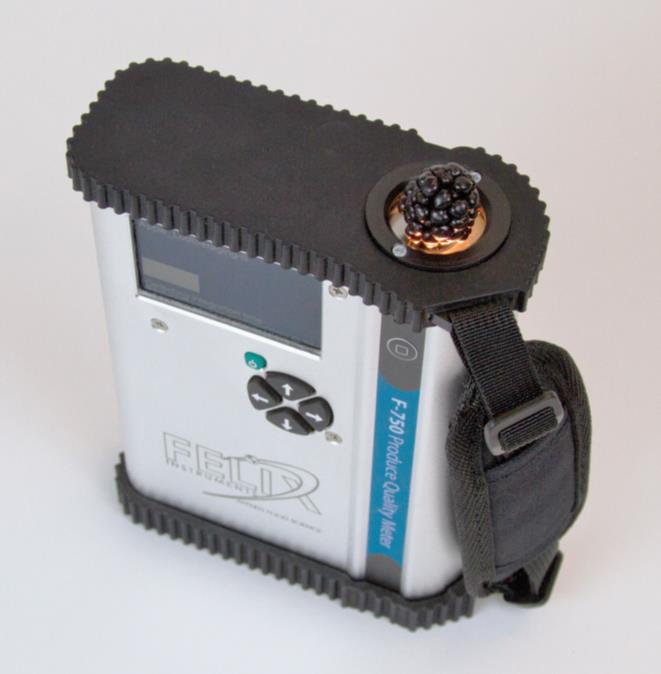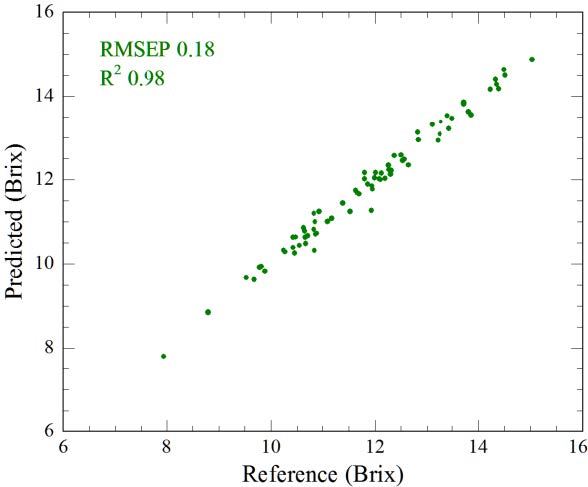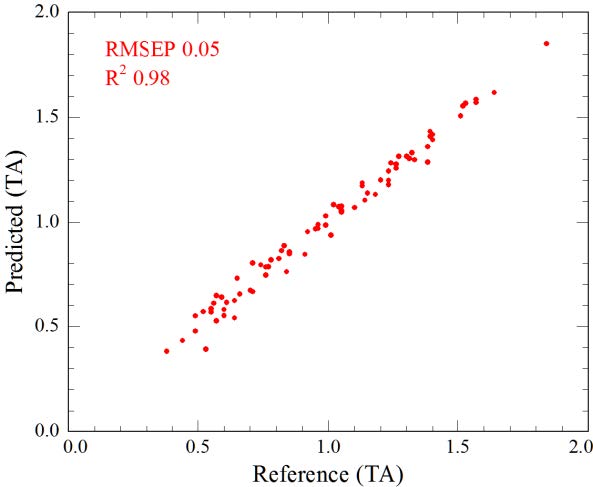April 21, 2016 at 11:06 pm | Updated April 21, 2016 at 11:06 pm | 3 min read
Simultaneous Non-destructive Measurements of Internal Quality Indicators in Blackberry (Rubus spp.)
Sugar and acid content are important metrics in determining proper harvest time and eating quality in blackberry (Rubus spp.). Using traditional methodology, sugar (Total Soluble Solids—TSS—or ºBrix) and acid (Titratable Acid (TA)) content measurements are destructively and time-consuming. To determine effectiveness and viability of the F-750 Produce Quality Meter for simultaneous, non-destructive measurements of TSS and TA in blackberries, a modeling study was conducted on 75 blackberries. Destructive reference values were correlated with the non-destructive spectral data collected with the F-750 using F-750 Model Builder Software, and results show that the F-750 Produce Quality Meter precisely and non-destructively measures TSS and TA in blackberries, with a calculated root mean square error of prediction of 0.18 TSS and 0.05 TA.
Materials and Methods:
Subscribe to the Felix instruments Weekly article series.
By submitting this form, you are consenting to receive marketing emails from: . You can revoke your consent to receive emails at any time by using the SafeUnsubscribe® link, found at the bottom of every email. Emails are serviced by Constant Contact
In June 2015, 75 blackberries were used to create a new model for the F-750 Produce Quality Meter. Blackberries were selected across a range of sizes and maturity. Using the screws on the lens housing as alignment markers, blackberries were consistently presented and scanned on the F-750 Produce Quality Meter. Each individually scanned blackberry was then destructively measured for TSS and TA. A few drops of juice from each berry was used for TSS refractometer measurements as described in Felix Instruments Mango Standard Operating Procedure (SOP), and the remaining blackberry juice was then measured for titratable acid (TA) using an automatic titrator. The spectral range of 801-975 nm was used by Model Builder Software to detect correlations between the F-750 spectral signal and corresponding TSS and TA values. The resulting regression data was analyzed for linearity, root mean square error, and leave-one-out cross validation error to determine the applicability and accuracy of the created model. A second population of 77 blackberries were measured and used to independently validate the blackberry model.

Figure 1. Fruit presentation for measuring blackberries with the F-750.
Results and Discussion:
Results show that the F-750 Produce Quality Meter precisely, simultaneously, and non-destructively measures the TSS and TA of blackberries. A strong correlation between spectral data and collected reference values is illustrated by a model prediction R2 of 0.98 for TSS and for TA. Figure 2 displays this correlation and demonstrates the consistency of measurement.
A calculated Root Mean Square Error of Prediction (RMSEP) of 0.18 TSS and 0.05 TA further illustrates the accuracy of the created model. This RMSEP value indicates the average uncertainty for a given measurement when the model is loaded onto the F-750 and used to predict TSS and TA. The RMSEP is equivalent to the expected uncertainty within 68% of all predictions.


Figure 2. F-750 prediction value against reference method value of TSS (a) and TA (b) in blackberries.
Conclusions:
The F-750 Produce Quality Meter accurately predicted Total Soluble Solids (TSS) and Titratable Acidity (TA) in blackberries. Tests and research findings in other commodities have demonstrated the ability to measure other important internal fruit metrics, such as dry matter, with the NIR technology. Similar results are expected for the F-750 Produce Quality Meter with other blackberry varieties and traits.
Further Reading and Supporting Science:
Du, X., Kurnianta, A., McDaniel, M., Finn, C., Qian, M. (2010). Flavour profiling of ‘Marion’ and thornless blackberries by instrumental and sensory analysis. Food Chemistry, 121: 1080-1088.
Huang, L., Wu, D., Jin, H., Zhang, J., He, Y., Lou, C. (2011). Internal quality determination of fruit with bumpy surface using visible and near infrared spectroscopy and chemometrics: A case study with mulberry fruit. Biosystems Engineering, 109: 377-384.
McGlone, A., Jordan, R., Seelye, R., Clark, C. (2003). Drymatter – a better predictor of the post-storage soluble solids in apples? Postharvest biology and technology, 28: 431–435.
Related Products
- F-751 Grape Quality Meter
- Custom Model Building
- F-901 AccuStore
- F-751 Melon Quality Meter
- F-751 Kiwifruit Quality Meter
- F-750 Produce Quality Meter
- F-751 Avocado Quality Meter
- F-751 Mango Quality Meter
- F-900 Portable Ethylene Analyzer
- F-950 Three Gas Analyzer
- F-920 Check It! Gas Analyzer
- F-960 Ripen It! Gas Analyzer
- F-940 Store It! Gas Analyzer
Most Popular Articles
- Spectrophotometry in 2023
- The Importance of Food Quality Testing
- NIR Applications in Agriculture – Everything…
- The 5 Most Important Parameters in Produce Quality Control
- Melon Fruit: Quality, Production & Physiology
- Guide to Fresh Fruit Quality Control
- Fruit Respiration Impact on Fruit Quality
- Liquid Spectrophotometry & Food Industry Applications
- Ethylene (C2H4) – Ripening, Crops & Agriculture
- Active Packaging: What it is and why it’s important


